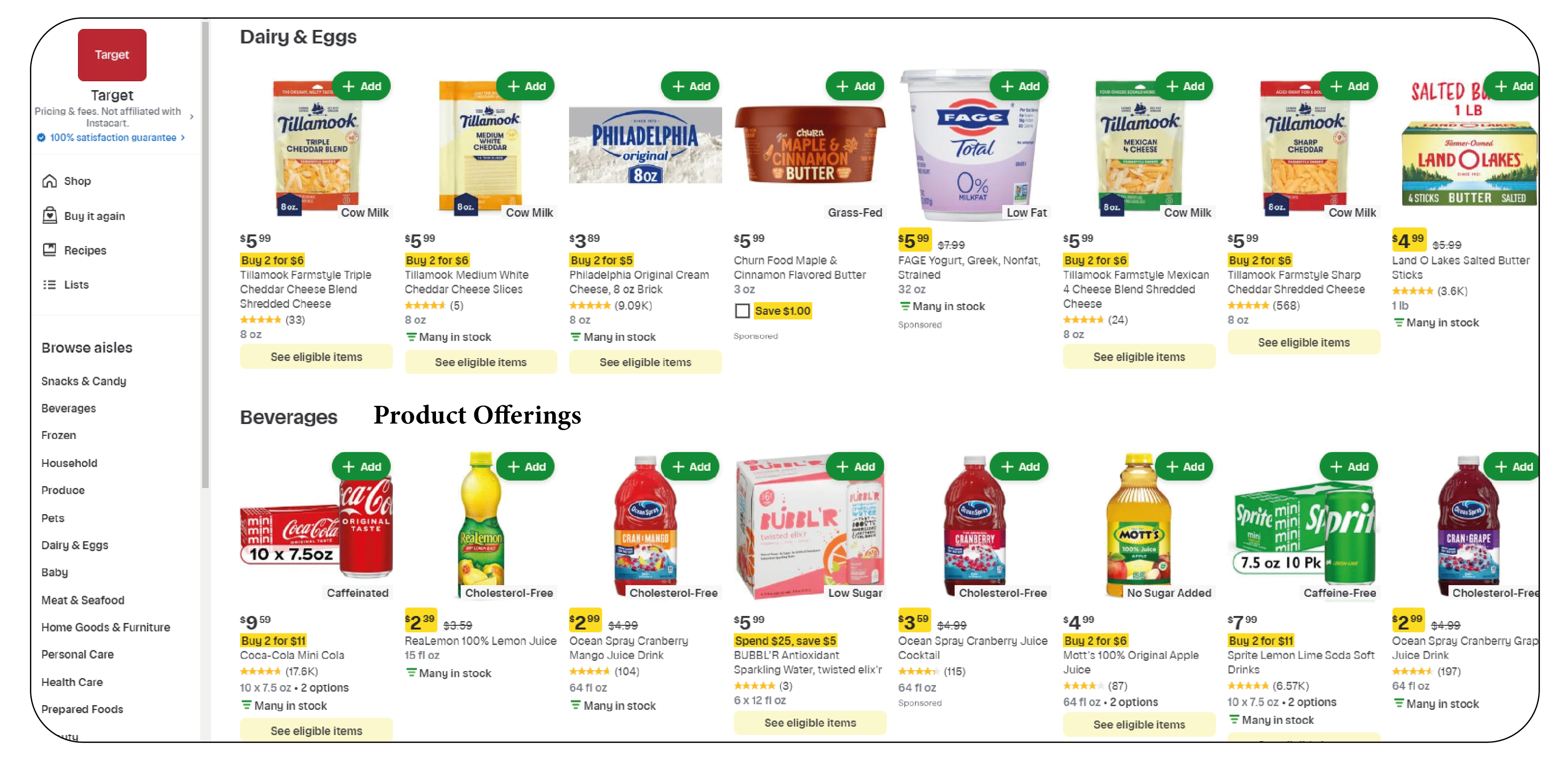
Introduction
In today's data-driven world, businesses, researchers, and developers constantly seek ways to gather relevant data from websites and apps to analyze trends, monitor competitor activities, and enhance their offerings. One such app that provides a wealth of data is Instacart, a popular online grocery delivery service. Scrape grocery details from the Instacart app acan offer valuable insights into product pricing, availability, seasonal trends, etc.
Instacart allows users to shop for groceries online and have them delivered to their doorstep, offering various products ranging from fresh produce to household essentials. Scraping the Instacart app 2024 allows businesses to collect valuable information to help make data-driven decisions, formulate pricing strategies, and identify market gaps. This article will walk you through the reasons to scrape grocery details from the Instacart app, how businesses can leverage this data, and provide a Grocery data scraping step-by-step DETAILS guide to scraping the data using Python and LXML.
Reasons to Scrape Grocery Details from the Instacart App

There are several reasons why scraping grocery details from the Instacart app can be beneficial for businesses and developers:
1. Competitive Analysis: One primary reason for scraping grocery data is to analyze competitors. By gathering data from Instacart, businesses can monitor their competitors' pricing strategies, identify trending products, and track changes in item availability. By focusing on the competition, businesses can better position themselves in the market and offer competitive prices or new products based on the insights gained from scraping. Instacart app grocery price scraping 2024 enables businesses to stay ahead in a competitive landscape.
2. Market Research: Scraping grocery data from Instacart enables businesses to analyze broader market trends. For example, by monitoring which products are frequently purchased or seeing fluctuations in product pricing, businesses can gain insights into consumer behavior and demand patterns. This information can be valuable for adjusting inventory or launching promotions that cater to consumer preferences. Instacart quick commerce data extraction can provide real-time updates on the market, offering valuable insights.
3. Tracking Seasonal Trends: Instacart offers detailed information on various product categories that change according to seasons or special promotions. By scraping data, businesses can identify when certain products or categories become more popular, helping them align their marketing efforts and stock management accordingly. For example, businesses can track trends related to holiday shopping, unique food items, or back-to-school grocery lists. Scraping Real-Time Trending Grocery Data for 2024 allows businesses to stay on top of seasonal demand shifts.
4. Price Comparison: Scraping grocery details from Instacart allows businesses to track product price fluctuations in real-time. This data can help businesses compare their prices against competitors, adjust their pricing strategy, and create dynamic pricing models based on the data scraped. Price scraping helps businesses ensure they remain competitive while maximizing profits. Instacart app product availability scraping also helps track price changes across different regions and product categories.
5. Stock Availability Monitoring: Scraping Instacart's grocery details also helps businesses monitor stock availability for products. By knowing which items are frequently out of stock, businesses can adjust their stock management systems or focus on sourcing more popular items to meet demand. This can improve customer satisfaction and help avoid stockouts. By Scraping Trending Grocery Data in 2024, businesses can predict which items might become popular and prepare their stock accordingly.
How Can Businesses Leverage Scraped Grocery Data for Competitive Advantage?

Scraped grocery data from Instacart can give businesses a range of advantages in decision-making, strategy formulation, and market positioning. Below are ways businesses can use scraped grocery data for a competitive edge:
1. Dynamic Pricing Strategies: Businesses can use scraped price data to develop dynamic pricing models. By tracking the prices of products across various competitors on Instacart, businesses can adjust their prices to stay competitive or optimize their pricing to increase profitability. With the help of web scraping APIs and tools, pricing adjustments can be automated based on predefined criteria, such as competitor price drops or market conditions. Instacart supermarket data collection service can facilitate this process by providing accurate and timely data.
2. Optimizing Product Catalog: Understanding which products are trending in the market can help businesses optimize their catalogs. For example, by scraping data related to frequently purchased products, businesses can prioritize stocking these items and phase out slow-moving inventory. Scraping data on product descriptions, categories, and customer ratings can also help improve product positioning in the market. Extract Instacart Grocery & Gourmet Food Data to offer insights into customer preferences and help businesses curate a better selection.
3. Improved Customer Insights: By analyzing the data scraped from Instacart, businesses can better understand customer preferences and behaviors. For example, businesses can track which products are most popular among different customer demographics, such as age, gender, or location. With this information, businesses can tailor their marketing campaigns and product offerings to meet customer needs better. The Instacart Grocery Dataset provides valuable customer-related insights for effective marketing and sales strategies.
4. Promotional Strategies: Businesses can leverage scraped data to optimize their promotional strategies. By monitoring which products are frequently discounted or promoted on Instacart, businesses can design targeted promotions or create bundles for popular items. Understanding the promotional trends within the app allows businesses to time their promotions more effectively, increasing sales and customer engagement. Instacart Quick Commerce Datasets enable businesses to track promotional activities and adapt accordingly.
5. Inventory Management: Scraping stock availability and product data can significantly enhance inventory management. With real-time data, businesses can forecast product demand and ensure they are always in stock. Monitoring competitor stockouts and availability trends can help businesses position themselves as the go-to source for popular grocery items. Web Scraping Instacart Grocery Data can continuously monitor stock levels, ensuring businesses stay ahead of demand fluctuations.
Steps to Scrape Grocery Details from the Instacart App Using Python and LXML
Now that we've discussed the reasons and benefits of scraping grocery data from Instacart, let's go over the detailed steps to scrape grocery details from the app using Python and LXML. This process involves several steps, including setting up the environment, sending HTTP requests, parsing HTML content, and extracting specific data.
Step 1: Install Required Libraries
Before you can begin scraping, you must install the necessary Python libraries. The primary libraries you will need are requests, LXML, and pandas for data storage.
pip install requests
pip install lxml
pip install pandas
Step 2: Inspect the Instacart Website

Before scraping any data, it's essential to understand the structure of the webpage you're targeting. You can inspect this by opening the Instacart app or the website's HTML source. Open the Instacart website in your browser, right-click, and select "Inspect" to view the HTML structure. Identify the elements you want to scrape, such as product names, prices, descriptions, and categories.
Step 3: Send an HTTP Request

Once you've identified the URL you want to scrape, the next step is to send an HTTP request to fetch the webpage's HTML content. You can use the requests library to send a GET request to the Instacart page.
import requests
url = "https://www.instacart.com/store/grocery-store"
response = requests.get(url)
html_content = response.content
Step 4: Parse the HTML Content Using LXML

Once you have the HTML content of the page, you can parse it using LXML to extract the data you need. LXML is fast and efficient for parsing HTML and XML documents. Here's how to parse the HTML content and extract the necessary elements:
from lxml import html
tree = html.fromstring(html_content)
Step 5: Extract the Data

Using XPaths, you can target specific elements on the webpage. For instance, XPath can extract product names, prices, and categories from the page.
Step 6: Store the Data in a Structured Format

Once you've scraped the data, you can store it in a structured format such as a pandas DataFrame for easy manipulation and analysis.
Step 7: Handle Pagination
Instacart may display products across multiple pages. To scrape all product details, you may need to handle pagination. This can be done by iterating over multiple pages using different URLs or by extracting the "next page" URL from the current page.
next_page = tree.xpath('//a[@class="next-page"]/@href')
Step 8: Respect Legal and Ethical Guidelines

When scraping data, always respect the website's robots.txt file and the app's terms of service. It is essential to overload the server with only a few requests quickly.
Step 9: Automate the Process

For regular data scraping, you can automate the entire process using cron jobs or task schedulers to run the script at specific intervals, ensuring you always have up-to-date data from Instacart.
Conclusion
Web Scraping Grocery & Gourmet Food Data from the Instacart app provides valuable insights into pricing strategies, product trends, and competitor activities. Following the abovementioned steps, businesses can efficiently gather and utilize this data to gain a competitive edge, optimize pricing strategies, and enhance customer satisfaction. As the grocery industry becomes increasingly competitive, leveraging scraped data can make a significant difference in positioning a business for success. However, it's essential always to consider legal and ethical guidelines when scraping data to avoid legal issues and respect website terms of service.
At Product Data Scrape, we strongly emphasize ethical practices across all our services, including Competitor Price Monitoring and Mobile App Data Scraping. Our commitment to transparency and integrity is at the heart of everything we do. With a global presence and a focus on personalized solutions, we aim to exceed client expectations and drive success in data analytics. Our dedication to ethical principles ensures that our operations are both responsible and effective.



























.webp)
-01.webp)
.webp)

.webp)